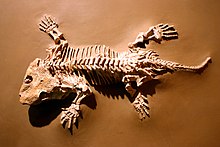Our website is made possible by displaying online advertisements to our visitors.
Please consider supporting us by disabling your ad blocker.
Seymouriamorpha
| Seymouriamorpha | |
|---|---|

| |
| Fossil of Seymouria in the National Museum of Natural History | |
| Scientific classification | |
| Domain: | Eukaryota |
| Kingdom: | Animalia |
| Phylum: | Chordata |
| Clade: | Reptiliomorpha (?) |
| Order: | †Seymouriamorpha Watson, 1917 |
| Subgroups | |
Seymouriamorpha were a small but widespread group of limbed vertebrates (tetrapods). They have long been considered stem-amniotes (reptiliomorphs), and most paleontologists still accept this point of view, but some analyses suggest that seymouriamorphs are stem-tetrapods (not more closely related to Amniota than to Lissamphibia).[2]
Many seymouriamorphs were terrestrial or semi-aquatic. However, aquatic larvae bearing external gills and grooves from the lateral line system have been found, making them unquestionably non-amniotes. As they matured, they became more terrestrial and reptile-like. They ranged from 30 cm (1 ft) long lizard-sized creatures to the 1.5 m (5 ft) long Enosuchus. If seymouriamorphs are reptiliomorphs, they were the distant relatives of amniotes.
Seymouriamorphs are divided into three main groups: Kotlassiidae, Discosauriscidae, and Seymouriidae, which includes the best-known genus, Seymouria. The last seymouriamorphs became extinct by the end of the Permian.[3]
- ^ Klembara, J.; Werneburg, R.; Mikudíková, M.; Šurka, J.; Štamberg, S. (2023). "The oldest records of the stem amniote Discosauriscus (Seymouriamorpha, Discosauriscidae) from the European Carboniferous-Permian boundary". Bulletin of Geosciences. 98 (3): 233–246. doi:10.3140/bull.geosci.1882.
- ^ Laurin, Michel (2010). How Vertebrates Left the Water. Berkeley: University of California Press. ISBN 978-0-520-26647-6.
- ^ Bulanov VV (2003). "Evolution and systematics of seymouriamorph parareptiles". Paleontological Journal. 37 (Supplement 1): 1–105.
Previous Page Next Page


